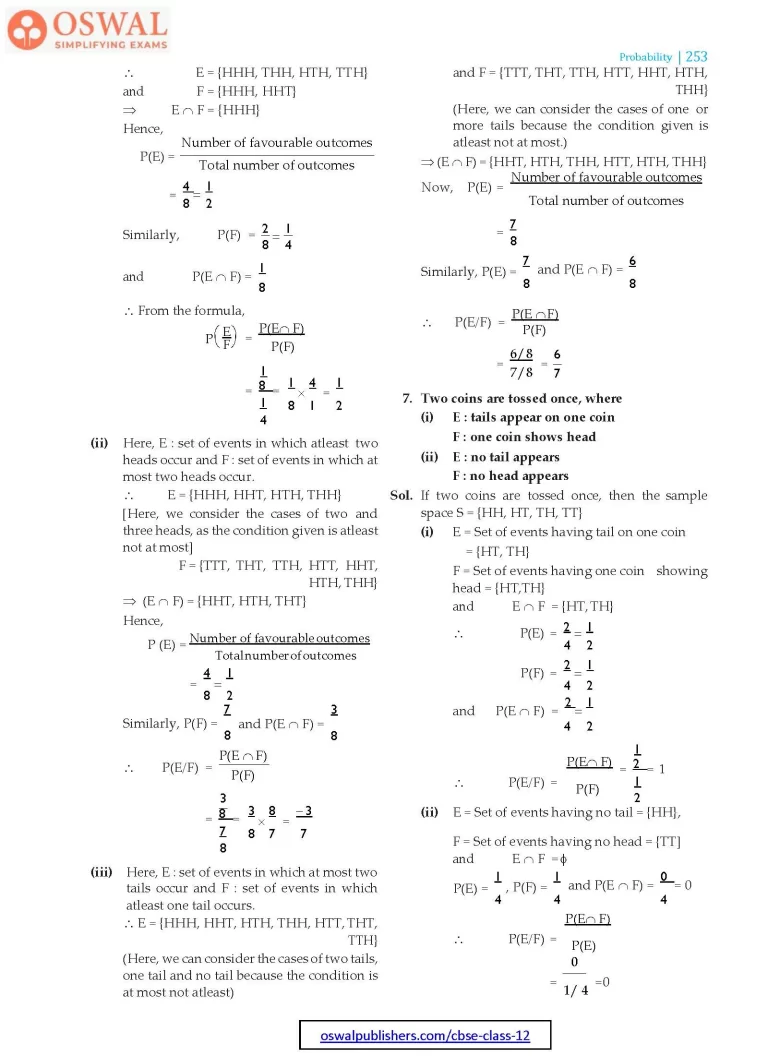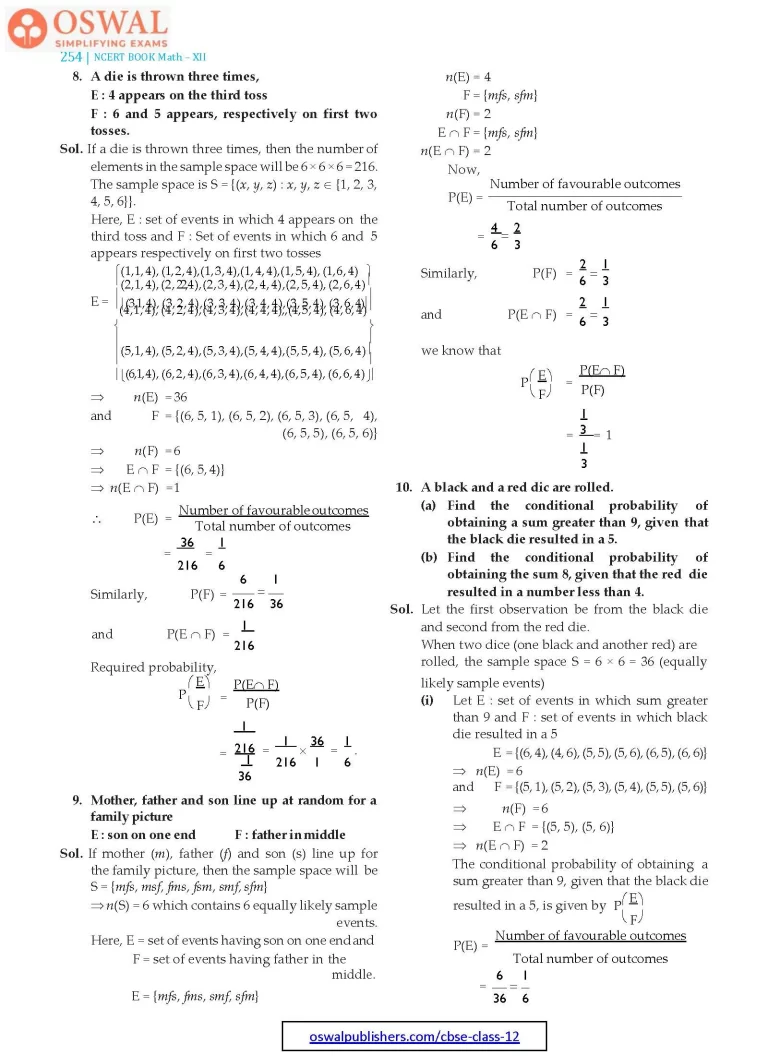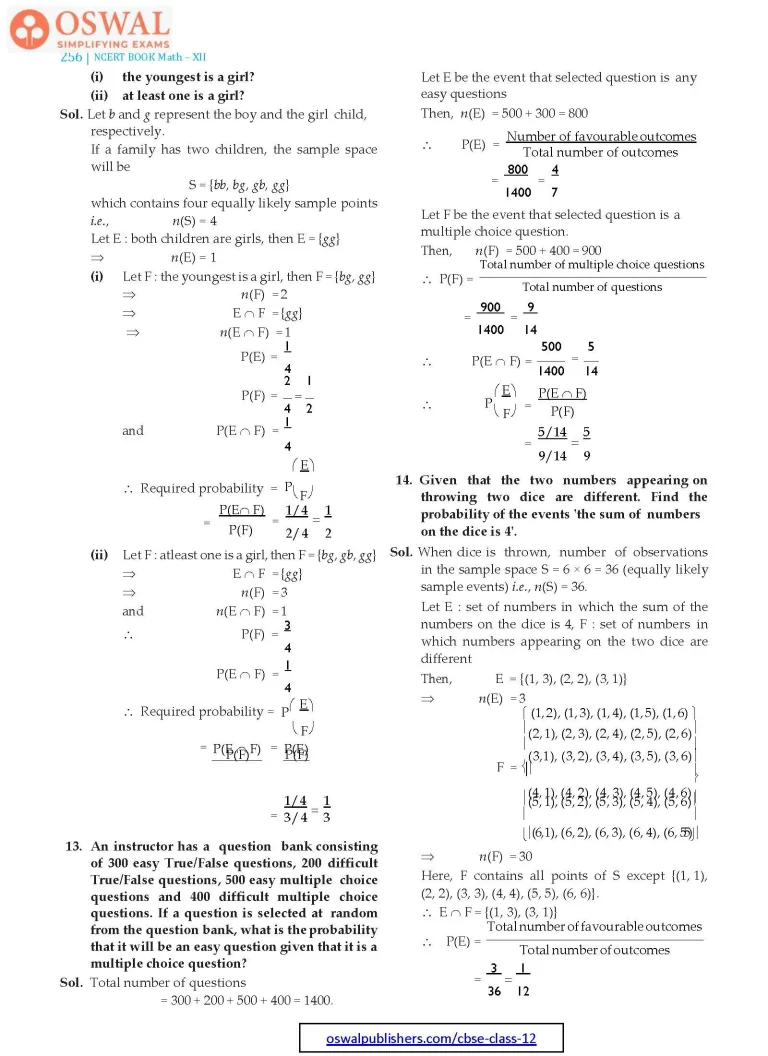NCERT Solutions for Class 12 Maths Chapter 13 - Probability - Exercise 13.1






Access Exercises of Class 12 Maths Chapter 13 – Probability
Exercise 13.1 Solutions 17 Questions
Exercise 13.2 Solutions 18 Questions
Exercise 13.3 Solutions 14 Questions
Exercise 13.4 Solutions 17 Questions
Exercise 13.5 Solutions 15 Questions
Miscellaneous Exercise on Chapter 13 Solutions 10 Questions
Exercise 13.1
1. Given that E and F are events such that P(E) = 0.6, P(F) = 0.3 and P(E ∩ F) = 0.2, find P(E/F) and P(F/E).
Sol. It is given that P(E) = 0.6, P(F) = 0.3 and P(E ∩ F) = 0.2
∴ We know that
$$\text{P}\bigg(\frac{\text{E}}{\text{F}}\bigg) = \frac{\text{P(E}\cap\text{F})}{\text{P(F)}}\\=\frac{0.2}{0.3}=\frac{2}{3}\\\text{and}\space\text{P}\bigg(\frac{\text{F}}{\text{E}}\bigg) = \frac{\text{P}(\text{F}\cap\text{E})}{\text{P(E)}}\\=\frac{0.2}{0.6}=\frac{1}{3}$$
2. Compute P(A/B), if P(B) = 0.5 and P(A ∩ B) = 0.32.
Sol. It is given that P(B) = 0.5 and P(A ∩ B) = 0.32
$$\therefore\space\text{P}\bigg(\frac{A}{B}\bigg) = \frac{\text{P}(A\cap B)}{\text{P(B)}}\\=\frac{0.32}{0.5} =\frac{32}{50} =\frac{16}{25} $$
3. If P(A) = 0.8, P(B) = 0.5 and P(B/A) = 0.4, find (i) P(A ∩ B) (ii) P(A/B) (iii) P(A ∪ B)
Sol. (i) Given, P(A) = 0.8, P(B) = 0.5, P(B/A) = 0.4
$$\Rarr\space\frac{\text{P}(A\cap\text{B})}{\text{P(A)}} = 0.4\\\bigg[\because\space\text{P}\bigg(\frac{B}{A}\bigg) = \frac{\text{P(A}\cap B)}{\text{P(A)}}\bigg]\\\Rarr\space \frac{\text{P}(A\cap B)}{0.8} = 0.4\\\Rarr\space P(A\cap B) = 0.8×0.4 = 0.32\\\text{(ii)\space}\text{P}\bigg(\frac{A}{B}\bigg) = \frac{\text{P}(A \cap B)}{\text{P(B)}}\\=\frac{0.32}{0.5} = \frac{32}{50} = 0.64 $$
(iii) From the relation
P(A ∪ B) = P(A) + P(B) – P(A ∩ B)
= 0.8 + 0.5 – 0.32
= 1.3 – 0.32 = 0.98
4. Evaluate P(A ∪ B), if 2P(A) =
$$\text{P}(\text{B}) = \frac{5}{13}\space\text{and}\space\text{P}\bigg(\frac{A}{B}\bigg) \textbf{=} \frac{\textbf{2}}{\textbf{5}}\textbf{.}\\\textbf{Sol.\space}\text{Given,\space}\text{2P(A) = P(B)} =\frac{5}{13}\\\Rarr\space\text{P(A)} = \frac{5}{26}\\\Rarr\space\text{P(B)} = \frac{5}{13}\\\text{Now,\space}\text{P(A/B)} =\frac{\text{P}(A\cap B)}{\text{P(B)}}\\\Rarr\space \frac{2}{5} =\frac{\text{P(A}\cap B)}{\frac{5}{13}}\\\Rarr\space \text{P(A}\cap \text{B})= \frac{2}{5}×\frac{5}{13} = \frac{2}{13}$$
Again, P(A ∪ B) = P(A) + P(B) – P(A ∩ B)
$$ = \frac{5}{26} + \frac{5}{13} -\frac{2}{13}\\ = \frac{5 + 10-4}{26} = \frac{11}{26}$$
$$\textbf{5. If P(A)} =\frac{\textbf{6}}{\textbf{11}},\textbf{P(B)} =\frac{\textbf{5}}{\textbf{11}}\\\textbf{and}\space\textbf{P(A}\cup\textbf{B}\textbf{) = }\frac{\textbf{7}}{\textbf{11}},\space\textbf{Find}\\\textbf{(i) P(A ∩ B)}\\\textbf{(ii)\space}\textbf{P}\bigg(\frac{\textbf{A}}{\textbf{B}}\bigg)\\\textbf{(iii)\space}\textbf{P}\bigg(\frac{\textbf{B}}{\textbf{A}}\bigg)\\\textbf{Sol.}\space\text{(i) Given,}\space\text{P(A}\cup\text{B}) = \frac{7}{11},\\\text{P(A)} = \frac{6}{11},\text{P(B)} =\frac{5}{11}\\\therefore\space\text{We known that}\\\text{P}(A\cup \text{B}) = \\\text{P(A)} + \text{P(B)} - P(A\cap B)$$
$$\Rarr\space \frac{7}{11} = \frac{6}{11} + \frac{5}{11} -\text{P(A}\cap B)\\\Rarr\space \text{P}(\text{A}\cap\text{B}) =\\ \frac{6}{11} + \frac{5}{11} -\frac{7}{11} =\frac{4}{11} $$
(ii) We know that
$$\text{P}\bigg(\frac{A}{B}\bigg) =\frac{\text{P}(A \cap B)}{\text{P(B)}}\\\Rarr\space \text{P}\bigg(\frac{A}{B}\bigg) =\frac{\frac{4}{11}}{\frac{5}{11}} \\=\frac{4}{11}×\frac{11}{5} = \frac{4}{5}\\\bigg(\because\space\text{P(B)} = \frac{5}{11}\space\text{given}\bigg)$$
(iii) We know that
$$\text{P}\bigg(\frac{\text{B}}{A}\bigg) = \frac{\text{P}(B\cap A)}{\text{P(A)}}\\$$
$$\Rarr\space\text{P}\bigg(\frac{B}{A}\bigg) = \frac{\frac{4}{11}}{\frac{6}{11}}\\=\frac{4}{11}×\frac{11}{6}\\=\frac{4}{6} =\frac{2}{3}\\\lbrack\because\space \text{P}(A \cap B) = \text{P}(B\cap A)\rbrack$$
Direction (Q. 6 to 9) : Determine P(E/F).
6. A coin is tossed three times, where
(i) E : head on third toss
F : head on first two tosses
(ii) E : at least two heads
F : at most two heads
(iii) E : at most two tails
F : atleast one tail
Sol. When a coin is tossed three times, the sample space S contains 23 = 8 equally likely sample points.
∴ S = {HHH, HHT, HTH, HTT, THH, THT, TTH, TTT}
(i) Here, E : set of events in which head occurs on third toss and F : set of events in which heads occur on first two tosses,
∴ E = {HHH, THH, HTH, TTH}
and F = {HHH, HHT}
⇒ E ∩ F = {HHH}
Hence,
$$\text{P(E)} = \frac{\text{Number of favourable outcomes}}{\text{Total number of outcomes}}\\=\frac{4}{8} = \frac{1}{2}\\\text{Similarly},\space\text{P(F)} =\frac{2}{8}=\frac{1}{4}\\\text{and}\space\text{P(E}\cap \text{F}) = \frac{1}{8}\\\therefore\space\text{From the formula,}\\\text{P}\bigg(\frac{\text{E}}{\text{F}}\bigg) = \frac{\text{P(E}\cap \text{F})}{\text{P(F)}}\\=\frac{\frac{1}{8}}{\frac{1}{4}} =\frac{1}{8}×\frac{4}{1} = \frac{1}{2}$$
(ii) Here, E : set of events in which atleast two heads occur and F : set of events in which at most two heads occur.
∴ E = {HHH, HHT, HTH, THH}
[Here, we consider the cases of two and three heads, as the condition given is atleast not at most]
F = {TTT, THT, TTH, HTT, HHT, HTH, THH}
⇒ (E ∩ F) = {HHT, HTH, THT}
Hence,
$$\text{P(E)} = \frac{\text{Number of favourable outcomes}}{\text{Total number of outcomes}}\\=\frac{4}{8} =\frac{1}{2}\\\text{Similarly, P(F)} =\frac{7}{8}\\\text{and}\space\text{P(E}\cap\text{F}) =\frac{3}{8}\\\therefore\space\text{P}\bigg(\frac{E}{F}\bigg) = \frac{\text{P}(E\cap F)}{\text{P}(\text{F})}\\=\frac{\frac{3}{8}}{\frac{7}{8}} = \frac{3}{8}×\frac{8}{7} = \frac{-3}{7}$$
(iii) Here, E : set of events in which at most two tails occur and F : set of events in which atleast one tail occurs.
∴ E = {HHH, HHT, HTH, THH, HTT, THT, TTH}
(Here, we can consider the cases of two tails, one tail and no tail because the condition is at most not atleast) and F = {TTT, THT, TTH, HTT, HHT, HTH, THH}
(Here, we can consider the cases of one or more tails because the condition given is atleast not at most.)
$$\Rarr\space (\text{E}\cap\text{F}) = \\\space\text{{HHT, HTH, THH, HTT, HTH, THH}}\\\text{Now,\space P(E)} =\\\frac{\text{Number of favourable outcomes}}{\text{Total number of outcomes}}\\=\frac{7}{8}\\\text{Similarly, P(E) =}\frac{7}{8}\space\\\text{and P(E }\cap \text{F}) = \frac{6}{8}\\\therefore\space \text{P}\bigg(\frac{\text{E}}{\text{F}}\bigg) =\frac{\text{P}(\text{E}\cap \text{F})}{\text{P(F)}}\\=\frac{\frac{6}{8}}{\frac{7}{8}} = \frac{6}{7}$$
7. Two coins are tossed once, where
(i) E : tails appear on one coin
F : one coin shows head
(ii) E : no tail appears
F : no head appears
Sol. If two coins are tossed once, then the sample space S = {HH, HT, TH, TT}
(i) E = Set of events having tail on one coin
= {HT, TH}
F = Set of events having one coin showing head = {HT,TH}
and E ∩ F = {HT, TH}
$$\therefore\space\text{P(E)} = \frac{2}{4}= \frac{1}{2}\\\text{P}(\text{F}) = \frac{2}{4} =\frac{1}{2}\\\text{and}\space\text{P}(\text{E}\cap\text{F}) =\frac{2}{4}=\frac{1}{2}\\\therefore\space\text{P}\bigg(\frac{\text{E}}{\text{F}}\bigg) = \frac{\text{P}(\text{E}\cap\text{F})}{\text{P(F)}}\\=\frac{\frac{1}{2}}{\frac{1}{2}}=1$$
(ii) E = Set of events having no tail = {HH},
F = Set of events having no head = {TT}
and E ∩ F = Φ
$$\text{P(E)} = \frac{1}{4},\text{P(F)} =\frac{1}{4}\\\text{and}\space\text{P(E}\cap\text{F}) =\frac{0}{4} = 0\\\therefore\space\text{P}\bigg(\frac{\text{E}}{\text{F}}\bigg) = \frac{\text{P}(\text{E}\cap \text{F})}{\text{P(E)}}\\=\frac{0}{\frac{1}{4}} = 0$$
8. A die is thrown three times, E : 4 appears on the third toss F : 6 and 5 appears, respectively on first two tosses.
Sol. If a die is thrown three times, then the number of elements in the sample space will be 6 × 6 × 6 = 216.
The sample space is S = {(x, y, z) : x, y, z ∈ {1, 2, 3, 4, 5, 6}}.
Here, E : set of events in which 4 appears on the third toss and F : Set of events in which 6 and 5 appears respectively on first two tosses
$$\text{E} =\\\begin{Bmatrix}(1,1,4), (1,2,4),(1,3,4),(1,4,4)(1,5,4),\\(1,6,4)\\(2,1,4)(2,2,4)(2,3,4),(2,4,4),(2,5,4),\\(2,6,4)\\(3,1,4),(3,2,4),(3,3,4),(3,4,4),(3,5,4),\\(3,6,4)\\(4,1,4),(4,2,4),(4,3,4),(4,4,4),(4,5,4),\\(4,6,4)\\(5,1,4),(5,2,4),(5,3,4),(5,4,4),(5,5,4),\\(5,6,4)\\(6,1,4),(6,2,4),(6,3,4),(6,4,4),(6,5,4),\\(6,6,4)\end{Bmatrix}\\\Rarr\space\text{n(E)} = 36$$
and F = {(6, 5, 1), (6, 5, 2), (6, 5, 3), (6, 5, 4), (6, 5, 5), (6, 5, 6)}
⇒ n(F) = 6
⇒ E ∩ F = {(6, 5, 4)}
⇒ n(E ∩ F) = 1
$$\therefore\space\text{P(E)}=\\\frac{\text{Number of favourable outcomes}}{\text{Total number of outcomes}}\\=\frac{36}{216} = \frac{1}{6}\\\text{Similarly, P(F)} =\frac{6}{216}=\frac{1}{36}\\\text{and}\space\text{P(E}\cap \text{F}) =\frac{1}{216}\\\text{Required probability,}\\\text{P}\bigg(\frac{\text{E}}{\text{F}}\bigg) =\frac{\text{P}(\text{E}\cap \text{F})}{\text{P(F)}}\\=\frac{\frac{1}{216}}{\frac{1}{36}} =\frac{1}{216}×\frac{36}{1} = \frac{1}{6}.$$
9. Mother, father and son line up at random for a family picture
E : son on one end
F : father in middle
Sol. If mother (m), father (f) and son (s) line up for the family picture, then the sample space will be
S = {mfs, msf, fms, fsm, smf, sfm}
⇒ n(S) = 6 which contains 6 equally likely sample events.
Here, E = set of events having son on one end and
F = set of events having father in the middle.
E = {mfs, fms, smf, sfm}
n(E) = 4
F = {mfs, sfm}
n(F) = 2
E ∩ F = {mfs, sfm}
n(E ∩ F) = 2
Now,
$$\text{P}(\text{E}) =\\\frac{\text{Number of favourable outcomes}}{\text{Total number of outcomes}}\\=\frac{4}{6}=\frac{2}{3}\\\text{Similarly,\space}\\ \text{P(E)} = \frac{2}{6}=\frac{1}{3}\\\text{and}\space \text{P(E}\cap \text{F}) = \frac{2}{6} =\frac{1}{3}$$
we know that
$$\text{P}\bigg(\frac{\text{E}}{\text{F}}\bigg)= \frac{\text{P}(\text{E}\cap\text{F})}{\text{P(F)}}\\=\frac{\frac{1}{3}}{\frac{1}{3}}=1$$
10. A black and a red dic are rolled.
(a) Find the conditional probability of obtaining a sum greater than 9, given that the black die resulted in a 5.
(b) Find the conditional probability of obtaining the sum 8, given that the red die resulted in a number less than 4.
Sol. Let the first observation be from the black die and second from the red die.
When two dice (one black and another red) are rolled, the sample space S = 6 × 6 = 36 (equally likely sample events)
(i) Let E : set of events in which sum greater than 9 and F : set of events in which black die resulted in a 5
E = {(6, 4), (4, 6), (5, 5), (5, 6), (6, 5), (6, 6)}
⇒ n(E) = 6
and F = {(5, 1), (5, 2), (5, 3), (5, 4), (5, 5), (5, 6)}
⇒ n(F) = 6
⇒ E ∩ F = {(5, 5), (5, 6)}
⇒ n(E ∩ F) = 2
The conditional probability of obtaining a sum greater than 9, given that the black die resulted in a 5, is given by
$$\text{P}\bigg(\frac{\text{E}}{\text{F}}\bigg)\\\text{P(E)} = \\\frac{\text{Number of favourable outcomes}}{\text{Total number of outcomes}}\\=\frac{6}{36} = \frac{1}{6}\\\text{Similarly,\space P(F)} =\frac{6}{36}=\frac{1}{6}\\\text{and}\space\text{P}(\text{E}\cap\text{F}) = \frac{2}{36} =\frac{1}{18}\\\therefore\space \text{P}\bigg(\frac{\text{E}}{\text{F}}\bigg) = \frac{\text{P}(\text{E}\cap\text{F})}{\text{P(F)}}\\=\frac{\frac{1}{18}}{\frac{1}{6}} =\frac{1}{18}×\frac{6}{1} =\frac{1}{3}.$$
(ii) Let E : set of events having 8 as the sum of the observations.
F : set of events in which red die resulted in a (in any one die) number less than 4
∴ E = {(2, 6), (3, 5), (4, 4), (5, 3), (6, 2)}
$$\Rarr\space \text{n(E)} = 5\\\text{and}\space\text{F =}\\\begin{Bmatrix}(1,1),(1,2),(1,3),(2,1),(2,2),(2,3)\\(3,1),(3,2),(3,3),(4,1),(4,2),(4,3)\\(5,1),(5,2),(5,3),(6,1),(6,2),(6,3)\end{Bmatrix}\\\Rarr\space \text{n(F) = 18}\\\Rarr\space E\cap F =\lbrace(5,3),(6,2)\rbrace\\n(\text{E}\cap\text{F}) =2\\\text{Now,}\\\text{P(E)} =\\ \frac{\text{Number of favourable outcomes}}{\text{Total number of outcomes}}\\=\frac{5}{36}$$
$$\text{Similarly,\space}\text{P(F)} =\frac{18}{36}=\frac{1}{2}\\\text{and}\space \text{P(E}\cap \text{F}) =\frac{2}{36} =\frac{1}{18}$$
∴ Required probability,
$$\text{P(E/F)} = \frac{\text{P}(\text{E}\cap \text{F})}{\text{P(F)}} \\=\frac{\frac{1}{18}}{\frac{1}{2}}\\=\frac{1}{18}×\frac{2}{1} =\frac{1}{9}$$
11. A fair die is rolled. Consider events E = {1, 3, 5},
F = {2, 3} and G = {2, 3, 4, 5}. Find
(i) P(E/F) and P(F/E)
(ii) P(E/G) and P(G/E)
(iii) P(E ∪ F/G) and P(E ∩ F/G)
Sol. Here, the sample space is S = {1, 2, 3, 4, 5, 6}.
Given E = {1, 3, 5}, F = {2, 3} and G = {2, 3, 4, 5}
⇒ E ∩ F = {3}
E ∩ G = {3, 5}
E ∪ F = {1, 2, 3, 4, 5}
(E ∪ F) ∩ G = {2, 3, 5}
and (E ∩ F) ∩ G = {3}
$$\Rarr\space\text{n(S) = 6}$$
n(E) = 3
n(F) = 2
n(G) = 4
n(E ∩ F) = 1
n(E ∩ G) = 2
n[(E ∪ F) ∩ G] = 3
and n[(E ∩ F) ∩ G] = 1
∴ By the formula,
$$\text{Probability =}\\\frac{\text{Number of favourable events}}{\text{Total number of events}}\\\text{We have,}\space\\\text{P(E)} = \frac{3}{6} = \frac{1}{2}\\\text{P(F)} = \frac{2}{6} = \frac{1}{3}\\\text{P(G)} = \frac{4}{6} =\frac{2}{3}\\\text{P}(\text{E}\cap\text{F})= \frac{1}{6}\\\text{P}(E\cap \text{G})= \frac{2}{6} =\frac{1}{3}\\\text{P}\lbrack(\text{E}\cup \text{F})\cap \text{G}\rbrack = \frac{3}{6} =\frac{1}{2}$$
$$\text{and}\space\\\text{P}\lbrack(\text{E}\cap\text{F})\cap\text{G}\rbrack =\frac{1}{6}\\\text{(i)\space P}\bigg(\frac{\text{E}}{\text{F}}\bigg) = \frac{\text{P}(\text{E}\cap\text{F})}{\text{P(F)}}\\=\frac{\frac{1}{6}}{\frac{1}{3}}=\frac{1}{2}\\\text{and}\space \text{P}\bigg(\frac{\text{F}}{\text{E}}\bigg) =\frac{\text{P(F}\cap\text{E})}{\text{P(E)}}\\=\frac{\frac{1}{6}}{\frac{1}{2}}=\frac{1}{3}\\\text{(ii)\space}\text{P}\bigg(\frac{\text{E}}{\text{G}}\bigg) = \frac{\text{P}(\text{E}\cap G)}{\text{P(G)}}$$
$$=\frac{\frac{1}{3}}{\frac{2}{3}} = \frac{1}{2}\\\text{and}\space \text{P}\bigg(\frac{G}{E}\bigg) =\frac{\text{P}(G\cap E)}{\text{P(E)}}\\=\frac{\frac{1}{3}}{\frac{1}{2}} =\frac{2}{3}\\\text{(iii)\space}\text{P}\bigg(\frac{E\cap F}{\text{G}}\bigg) =\\\frac{P\lbrack (E\cup F)\cap G\rbrack}{\text{P(G)}}\\=\frac{\frac{1}{2}}{\frac{2}{3}} =\frac{3}{4}$$
$$\text{and}\space\text{P}\bigg(\frac{\text{E}\cap \text{F}}{\text{G}}\bigg) = \\\frac{\text{P}\lbrack(\text{E}\cap\text{F})\cap G\rbrack}{\text{P(G)}}\\=\frac{\frac{1}{6}}{\frac{2}{3}} = \frac{1}{4}$$
12. Assume that each born child is equally likely to be a boy or a girl. If a family has two children, what is the conditional probability that both are girls given that
(i) the youngest is a girl?
(ii) at least one is a girl?
Sol. Let b and g represent the boy and the girl child, respectively.
If a family has two children, the sample space will be
S = {bb, bg, gb, gg}
which contains four equally likely sample points i.e.,
n(S) = 4
Let E : both children are girls, then E = {gg}
⇒ n(E) = 1
(i) Let F : the youngest is a girl, then F = {bg, gg}
⇒ n(F) = 2
⇒ E ∩ F = {gg}
⇒ n(E ∩ F) = 1
$$\text{P(E)} =\frac{1}{4}\\\text{P(F)} =\frac{2}{4}=\frac{1}{2}\\\text{and}\space\text{P}(E\cap F)= \frac{1}{4}\\\therefore\space\text{Required probability} =\text{P}\bigg(\frac{\text{E}}{\text{F}}\bigg)\\=\frac{\text{P}(\text{E}\cap\text{F})}{\text{P(F)}}\\=\frac{\frac{1}{4}}{\frac{2}{4}} =\frac{1}{2}$$
(ii) Let F : atleast one is a girl, then F = {bg, gb, gg}
⇒ E ∩ F = {gg}
⇒ n(F) = 3
and n(E ∩ F) = 1
$$\therefore\space \text{P(F)} =\frac{3}{4}\\\text{P(E}\cap \text{F}) =\frac{1}{4}\\\therefore\space\text{Required probability} =\text{P}\bigg(\frac{\text{E}}{\text{F}}\bigg)\\=\frac{\text{P}(\text{E}\cap\text{F})}{\text{P(F)}} =\frac{\text{P(E)}}{\text{P(F)}}\\=\frac{\frac{1}{4}}{\frac{3}{4}}= \frac{1}{3}$$
13. An instructor has a question bank consisting of 300 easy True/False questions, 200 difficult True/False questions, 500 easy multiple choice questions and 400 difficult multiple choice questions. If a question is selected at random from the question bank, what is the probability that it will be an easy question given that it is a multiple choice question?
Sol. Total number of questions
= 300 + 200 + 500 + 400 = 1400.
Let E be the event that selected question is any easy questions
Then, n(E) = 500 + 300 = 800
$$\therefore\space\text{P(E) =}\frac{\text{Number of favourable outcomes}}{\text{Total number of outcomes}}\\ = \frac{800}{1400} =\frac{4}{7}$$
Let F be the event that selected question is a multiple choice question.
Then, n(F) = 500 + 400 = 900
$$\therefore\space\text{P(F)} =\\\frac{\text{Total number of multiplechoice questions}}{\text{Total number of queestions}}\\=\frac{900}{1400} =\frac{9}{14}\\\therefore\space \text{P}(\text{E}\cap\text{F}) = \frac{500}{1400} =\frac{5}{14}\\\therefore\space\text{P}\bigg(\frac{\text{E}}{\text{F}}\bigg) = \frac{\text{P(E}\cap \text{F})}{\text{P(F)}}\\=\frac{\frac{5}{14}}{\frac{9}{14}} = \frac{5}{9}$$
14. Given that the two numbers appearing on throwing two dice are different. Find the probability of the events 'the sum of numbers on the dice is 4'.
Sol. When dice is thrown, number of observations in the sample space S = 6 × 6 = 36 (equally likely sample events) i.e., n(S) = 36.
Let E : set of numbers in which the sum of the numbers on the dice is 4, F : set of numbers in which numbers appearing on the two dice are different
Then, E = {(1, 3), (2, 2), (3, 1)}
$$\Rarr\space n(\text{E}) = 3\\\text{F} = \begin{Bmatrix}(1,2),(1,3),(1,4),(1,5),(1,6)\\(2,1),(2,3),(2,4),(2,5),(2,6)\\(3,1),(3,2),(3,4),(3,5),(3,6)\\(4,1),(4,2),(4,3),(4,5),(4,6)\\(5,1),(5,2),(5,3),(5,4),(5,6)\\(6,1),(6,2),(6,3),(6,4),(6,5)\end{Bmatrix}\\\Rarr\space n(\text{F}) = 30$$
Here, F contains all points of S except {(1, 1), (2, 2), (3, 3), (4, 4), (5, 5), (6, 6)}.
∴ E ∩ F = {(1, 3), (3, 1)}
$$\therefore\space\text{P(E)} =\\\frac{\text{Total number of favourable outcomes}}{\text{Total number of outcomess}}\\=\frac{3}{36} =\frac{1}{12}\\\text{Similarly,}\space\text{P(F)} =\frac{30}{36} =\frac{5}{6}\\\text{and}\space\text{P(E}\cap \text{F}) = \frac{2}{36} =\frac{1}{18}$$
Hence, the required probability
$$= \text{P}\bigg(\frac{\text{E}}{\text{F}}\bigg) = \frac{\text{P}(\text{E}\cap\text{F})}{\text{P(F)}}\\=\frac{\frac{1}{18}}{\frac{5}{6}} =\frac{1}{15}$$
15. Consider the experiment of throwing a die, if a multiple of 3 comes up, throw the die again and if any other number comes, toss a coin. Find the conditional probability of the event 'the coin shows a tail', given that 'at least one die shows a 3'.
Sol. The outcomes of the given experiment can be represented by the following set :
The sample space of the experiment is
$$\text{S = }\begin{Bmatrix}(3,1),(3,2),(3,3),(3,4),(3,5),(3,6)\\(6,1),(6,2),(6,3),(6,4),(6,5),(6,6)\\(1,\text{H}),(1,\text{T}),(2,\text{H}),(2,\text{T}),(4,\text{H}),\\(4,\text{T}),(5,\text{H}),(5,\text{T})\end{Bmatrix}$$
n(S) = 20
Let E : the coin shows a tail, F : atleast one die shows up a 3,
E = {(1, T), (2, T), (4, T), (5, T)}
⇒ n(E) = 4
F = {(3, 1), (3, 2), (3, 3), (3, 4), (3, 5), (3, 6), (6, 3)}
⇒ n (F) = 7
⇒ E ∩ F = Φ
(because here is no common elements)
$$\therefore\space\text{P(E)} = \frac{\text{Favourable outcomes}}{\text{Total number of outcomes}}\\\frac{n(E)}{n(S)} = \frac{40}{20}= \frac{1}{5}\\\text{Similarly,}\\\space\text{P(F)} =\frac{n(\text{F})}{n(\text{S})} =\frac{7}{20}\\\text{and}\space \text{P(E}\cap \text{F}) = \frac{n(\text{E}\cap\text{F})}{\text{n(S)}}\\ =\frac{0}{20} = 0 $$
Hence, the required probability
$$ = \text{P}\bigg(\frac{\text{E}}{\text{F}}\bigg) =\frac{\text{P}(\text{E}\cap\text{F})}{\text{P}\text{(F)}} \\= \frac{0}{\frac{7}{20}} = 0.$$
Direction (Q. 16 to 17) : In each of the questions choose the correct answer.
$$\textbf{16.\space If P(A)}\space\textbf{=}\space\frac{\textbf{1}}{\textbf{2}}\textbf{,}\space\textbf{P(B) = 0,}\\\textbf{then P(A/B) is :}\\\textbf{(A)}\space \textbf{0}\\\textbf{(B)}\space\frac{\textbf{1}}{\textbf{2}}\\\textbf{(C)\space}\textbf{not defined}\\\textbf{(D)\space 1}$$
Sol. (C) not defined
$$\text{It is given that P(A) =}\frac{1}{2}\\\text{and P(B) = 0}\\\text{P}\bigg(\frac{\text{A}}{\text{B}}\bigg) = \frac{\text{P}(A\cap B)}{\text{P(B)}}\\=\frac{\text{P(A}\cap \text{B})}{0} =\infty$$
Therefore, P(A/B), is not defined.
17. If A and B are events such that P(A/B) = P(B/A), then :
(A) A ⊂ B but A ≠ B
(B) A = B
(C) A ∩ B = f
(D) P(A) = P(B)
Sol. (D) P(A) = P(B)
Here, P(A/B) = P(B/A)
∴ P(A ∩ B)/P(B) = P(B ∩ A)/P(A)
⇒ P(A) = P(B)
[∵ P(A ∩ B) = P(B ∩ A)]
Share page on
NCERT Solutions Class 12 Mathematics
- Chapter 1 Relations and Functions
- Chapter 2 Inverse Trigonometric Functions
- Chapter 3 Matrices
- Chapter 4 Determinants
- Chapter 5 Continuity and Differentiability
- Chapter 6 Application of Derivatives
- Chapter 7 Integrals
- Chapter 8 Applications of the Integrals
- Chapter 9 Differential Equations
- Chapter 10 Vectors
- Chapter 11 Three-Dimensional Geometry
- Chapter 12 Linear Programming
- Chapter 13 Probability
CBSE CLASS 12 NCERT SOLUTIONS
- NCERT Solutions Class 12 English Core
- NCERT Solutions Class 12 Physics
- NCERT Solutions Class 12 Chemistry
- NCERT Solutions Class 12 Biology
- NCERT Solutions Class 12 Business Studies
- NCERT Solutions Class 12 Mathematics
- NCERT Solutions Class 12 Accountancy
- NCERT Solutions Class 12 Economics
- NCERT Solutions Class 12 Geography
- NCERT Solutions Class 12 History
- NCERT Solutions Class 12 Political Science
CBSE CLASS 12 SYLLABUS
- CBSE Class 12 English core Syllabus
- CBSE Class 12 Mathematics Syllabus
- CBSE Class 12 Physics Syllabus
- CBSE Class 12 Chemistry Syllabus
- CBSE Class 12 Biology Syllabus
- CBSE Class 12 Accountancy Syllabus
- CBSE Class 12 Business Studies Syllabus
- CBSE Class 12 Economics Syllabus
- CBSE Class 12 History Syllabus
- CBSE Class 12 Geography Syllabus
- CBSE Class 12 Political science Syllabus
- CBSE Class 12 Sociology Syllabus
- CBSE Class 12 Psychology Syllabus
- CBSE Class 12 Physical education Syllabus
- CBSE Class 12 Applied mathematics Syllabus
- CBSE Class 12 History of Indian Arts Syllabus
CBSE CLASS 12 Notes
- CBSE Class 12 Physics Notes
- CBSE Class 12 Chemistry Notes
- CBSE Class 12 Biology Notes
- CBSE Class 12 Maths Notes
- CBSE Class 12 Accountancy Notes
- CBSE Class 12 Business Studies Notes
- CBSE Class 12 Economics Notes
- CBSE Class 12 History Notes
- CBSE Class 12 Geography Notes
- CBSE Class 12 Political Science Notes

